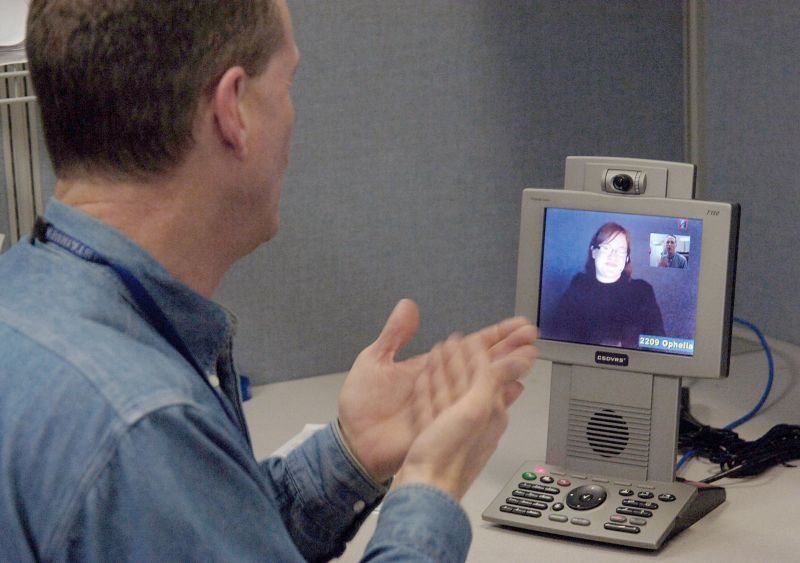Thanks to the installation of a new, technologically-advanced device called the Z-150, deaf/hearing impaired employees here now can speak to, and see, one another over the phone.
The Z-150 is a video phone system with a camera and monitor that allows communications to travel over the network, similar to a computer. It uses a relay interpreter service, so hearing-impaired employees can have conversations with other people who are not hearing impaired. A relay person, or a sign language interpreter, visually communicates to the hearing-impaired person who has the Z-150 through the monitor.
Susan McClintick, an information assurance specialist in the 72nd Air Base Wing Communications Directorate, worked with a team of three people for nearly two years to get the Z-150 certified and approved in compliance with Air Force standards.
“This is to help our hearing-impaired employees, so they will have less dependence on an interpreter or interpretation services,” Ms. McClintick said. “Our main goal was to make sure they weren’t going to use a product that later someone would come out and say, ‘Oh, you can’t use this.’ We wanted to make sure it was approved prior to them ordering and using it.”
Patty Wilson, a program analyst and sign language interpreter in the 76th Maintenance Wing Operations Office, is currently the only interpreter on base. She said the Z-150 system frees up a lot of her time interpreting the small items that can now be completed by using the Z-150.
Instead of Ms. Wilson having to physically meet with the hearing-impaired employees to interpret each time they use the phone, the Z-150 connects to an answering service and a live person signs and translates to the deaf caller.
Although one Z-150 was already installed within the Defense Logistics Agency on base, David Harman, an engineering technician in the 948th Supply Chain Management Group, was the first hearing impaired employee within the Tinker Air Force side to use a Z-150.
“It’s wonderful,” Mr. Harman said. “It helped me to be independent myself, and I can call anyone, anywhere. I don’t have to depend on people calling for me.”
Mr. Harman has been working at Tinker Air Force Base since 1985, and has seen many phone devices for hearing-impaired employees come and go. But the Z-150 is the fastest and most efficient system so far, he said.
Because of Mr. Harman’s experience and knowledge with video phones, Ms. Wilson chose him to be the first person to test the use of the phone and make sure it worked properly. Tinker Air Force Base now has five of the phone systems installed and several more have been ordered.
“We will order continuously until we finish getting all the deaf on base a Z-150, working with their supervisors,” Ms. Wilson said.
There are 100 to 150 people employed here who are deaf or hearing-impaired and will eventually need the Z-150 phones installed in their offices. The devices cost $399 per phone, but purchasers at Tinker AFB are able to get them free-of-charge through the Computer/Electronic Accommodations Program, which is funded through the Secretary of Defense, and is designated to help government employees with any type of disability.
Not only does the Z-150 have a camera and video capabilities, it has many other functions as well. It can be used between two hearing-impaired employees, which means an interpreter is not needed at all.
“The phone also allows hearing-impaired employees to call other people who have Z-150 phones, and the interpreter drops out of the picture,” Ms. McClintick said.
Also, if a person has a cochlear implant, a device that provides a sense of sound to hearing-impaired individuals, then that person has the option to actually speak to the interpreter from the answering service.
“So they have a right to use their voice if they choose to do so,” Ms. Wilson said. “But the interpreter will still sign.”
The sign language interpreters within the relay are part of an answering service provided through the Z-150 phone system. However, they are government employees, so they have a code of confidence that allows them to share and communicate any type of information they may see and hear.
Before the Z-150, Mr. Harman would primarily communicate through e-mail when he wasn’t relying on Ms. Wilson to interpret for him. With the new phone, he said he uses the Z-150 at least three or four times per day.
“I don’t have to bother Patty for the little things anymore,” Mr. Harman said. “It’s great technology and I appreciate this so much.”










